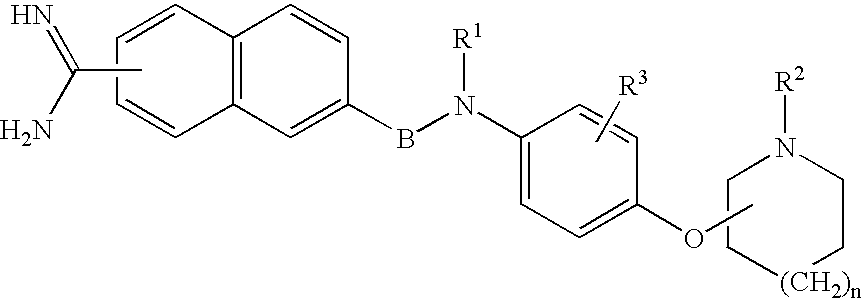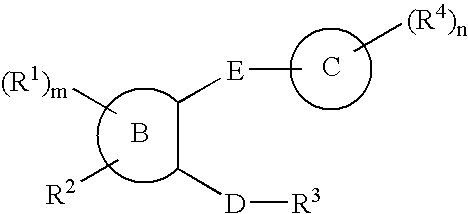Diazepan derivatives or salts thereof
a technology of diazepan and derivatives, which is applied in the field of diazepan derivatives, can solve the problems of difficult control of anticoagulation capacity, extremely difficult clinical use of drugs, and inability to administer thrombin inhibitors orally, and achieve excellent activation and inhibiting action of activated blood coagulation factor x
- Summary
- Abstract
- Description
- Claims
- Application Information
AI Technical Summary
Benefits of technology
Problems solved by technology
Method used
Image
Examples
example 42
(Example 42 of WO 99 / 00121) (Example 198 of WO 99 / 00121)
3) Test on Measurement of Enzyme Inhibition by Synthetic Substrate Method:
[0109]To a 96-well microplate were added 80 μl of a reaction buffer (pH 8.4), 15 μl of a drug and 30 μl of 2 mM synthetic substrate S-2222 (Chromogenix), then 25 μl of 0.025 U / ml of human activated blood coagulation factor X (Factor Xa; Enzyme Research Labs) was added, the reaction was carried out at 37° C. for 10 minutes, changes in absorbance 405 nm were measured by a Bio-Rad Model 3550 and IC50 was calculated. The compound of Example 1 exhibited an IC50 of 10 nM or less.
[0110]As a result of the measurements of the above 1), 2) and 3), it was confirmed that the compound of this invention inhibits human activated blood coagulation factor X in a specific manner and shows a potent anticoagulation action to blood. For example, the compounds shown in Examples 5, 9, 11, 32 and 39 of this invention were confirmed to clearly extend the coagulation time at low c...
referential example 1
[0124]Ethyl 4-bromomethyl-3-nitrobenzoate (26.00 g) was dissolved in 90 ml of acetonitrile, then 7.97 g of 3-aminobenzonitrile and 12.44 g of potassium carbonate were added and the mixture was stirred at 70° C. for 3 hours. The reaction solution was cooled to room temperature, and after filtration, the mother liquor was concentrated in vacuo. Ethyl acetate was added to the resulting residue. The mixture was washed with a 1N aqueous solution of hydrochloric acid and a saturated aqueous solution of sodium bicarbonate, dried over anhydrous magnesium sulfate and concentrated in vacuo. The resulting residue was purified by silica gel column chromatography using hexane-ethyl acetate (80:20 to 75:25) as an eluting solvent to give 12.06 g of ethyl 4-[(3-cyanophenylamino)methyl]-3-nitrobenzoate.
referential example 2
[0125]Ethyl 4-[(3-cyanophenylamino)methyl]-3-nitrobenzoate (5.79 g) was dissolved in 50 ml of ethanol, then 50 ml of purified water, 0.96 g of ammonium chloride and 4.97 g of iron powder were added and the mixture was refluxed under heating for 40 minutes. The reaction solution was filtered through Celite and concentrated in vacuo. Ethyl acetate was added to the resulting residue. The mixture was washed with a saturated aqueous solution of sodium bicarbonate and a saturated aqueous solution of sodium chloride, dried over anhydrous magnesium sulfate, concentrated in vacuo and dried to give 5.71 g of ethyl 3-amino-4-[(3-cyanophenylamino)methyl]benzoate.
PUM
| Property | Measurement | Unit |
|---|---|---|
| Mass | aaaaa | aaaaa |
| Mass | aaaaa | aaaaa |
| Mass | aaaaa | aaaaa |
Abstract
Description
Claims
Application Information
 Login to View More
Login to View More - R&D
- Intellectual Property
- Life Sciences
- Materials
- Tech Scout
- Unparalleled Data Quality
- Higher Quality Content
- 60% Fewer Hallucinations
Browse by: Latest US Patents, China's latest patents, Technical Efficacy Thesaurus, Application Domain, Technology Topic, Popular Technical Reports.
© 2025 PatSnap. All rights reserved.Legal|Privacy policy|Modern Slavery Act Transparency Statement|Sitemap|About US| Contact US: help@patsnap.com



